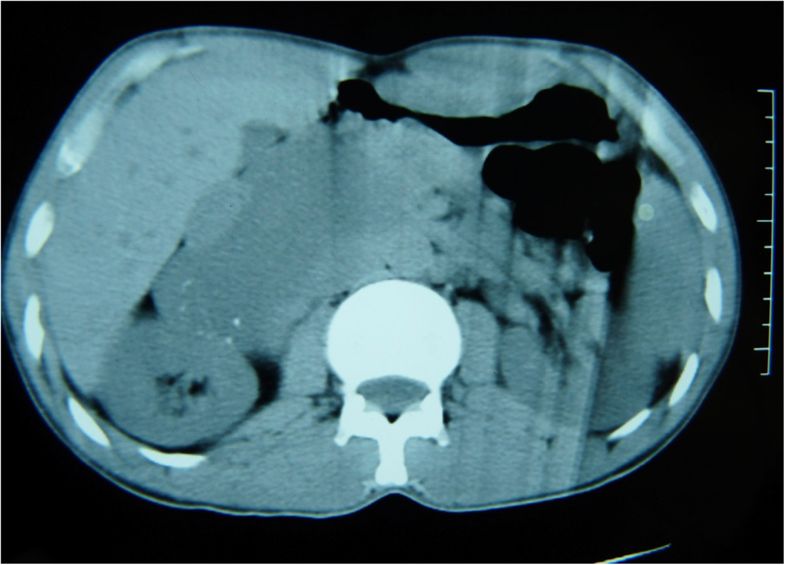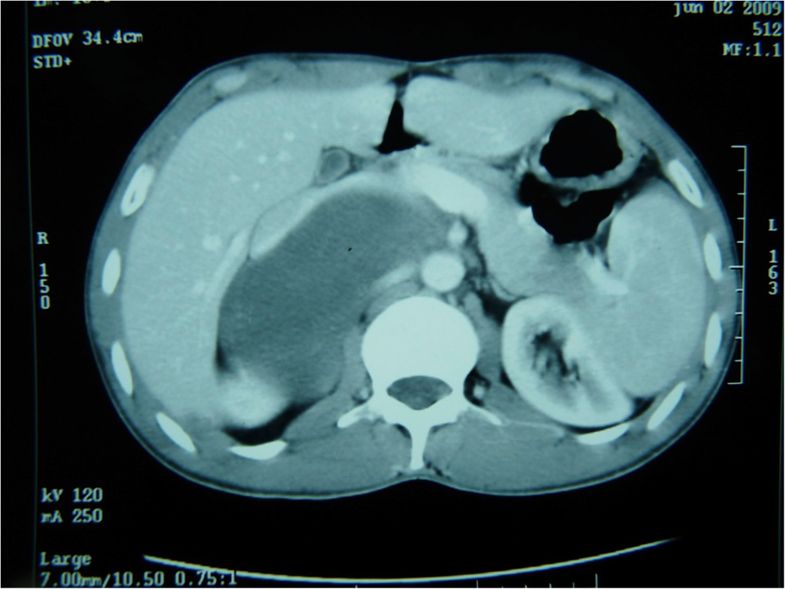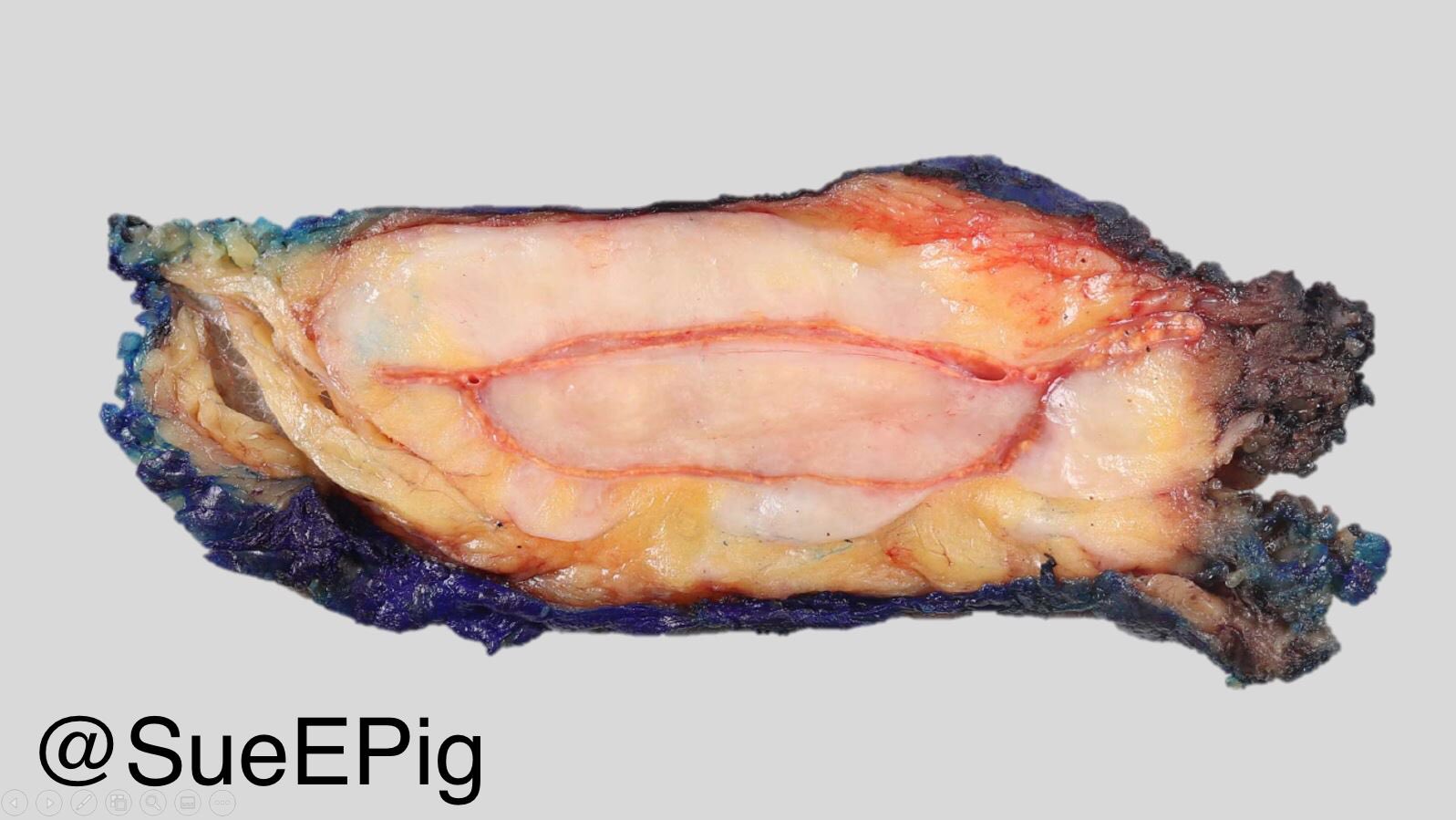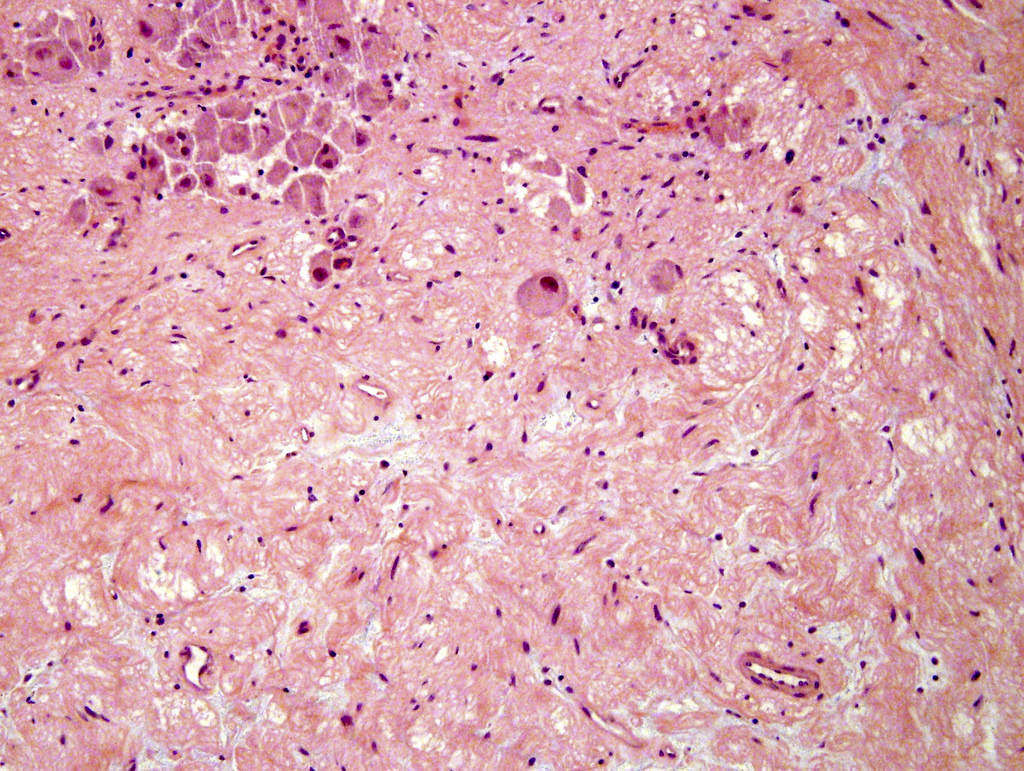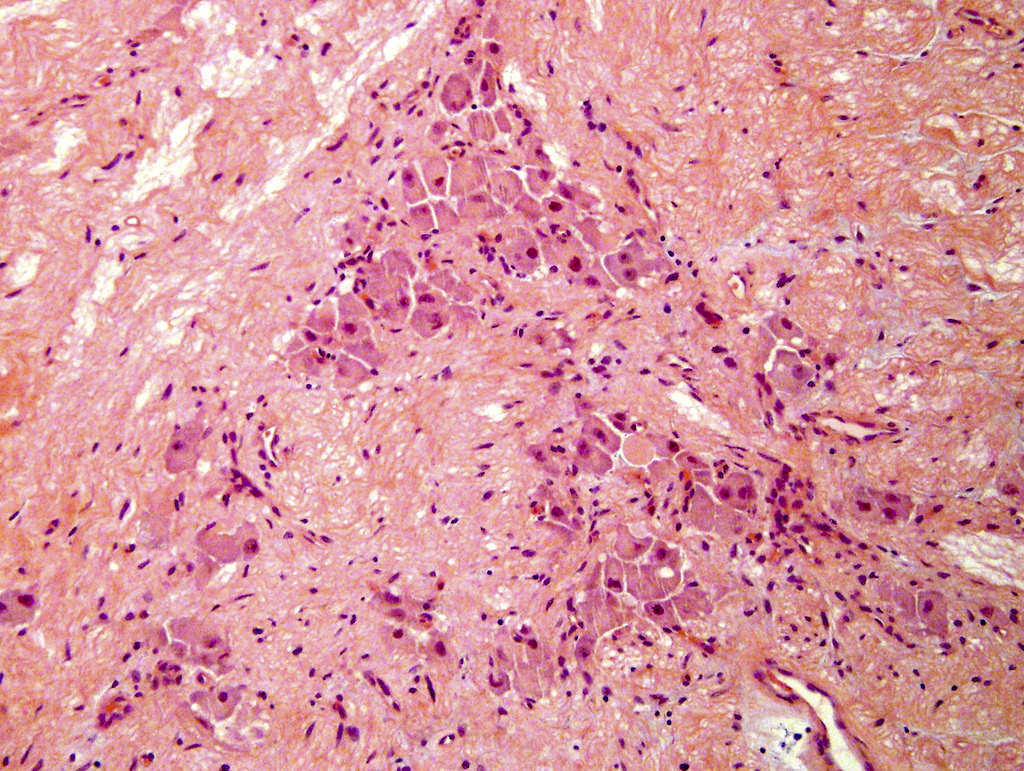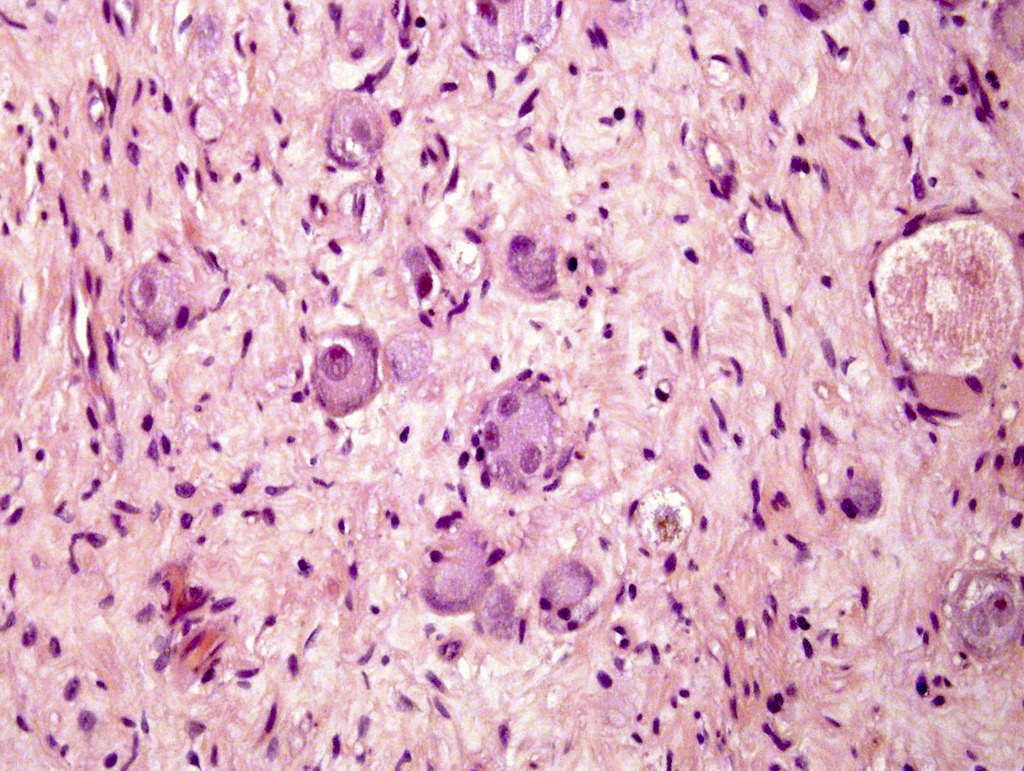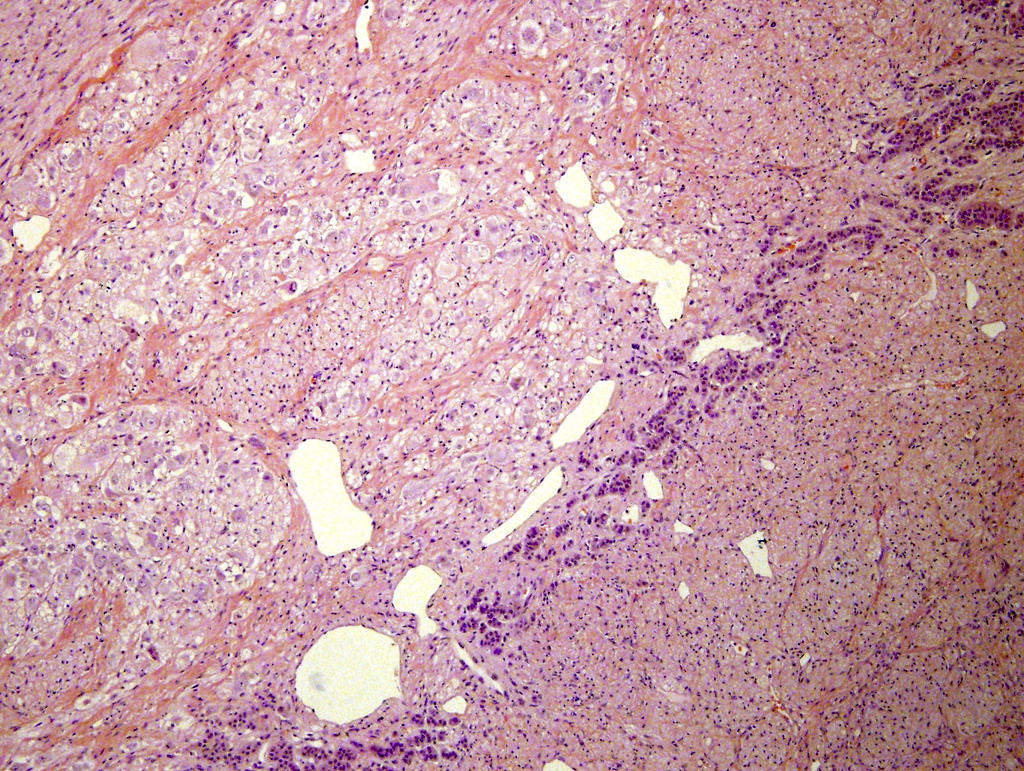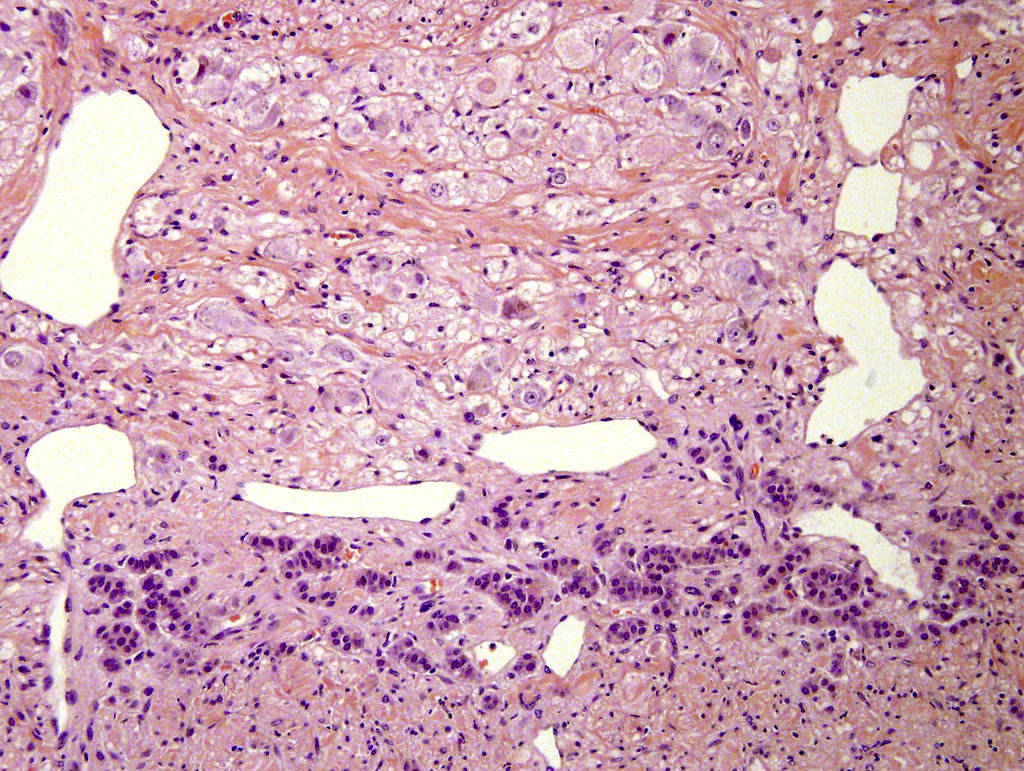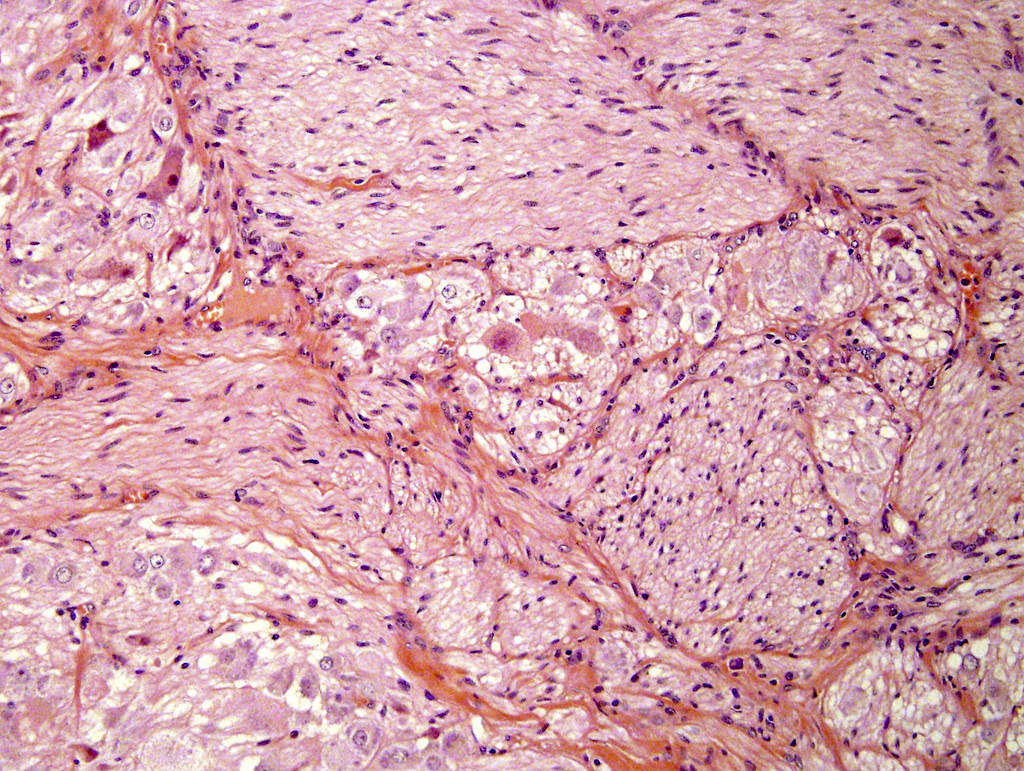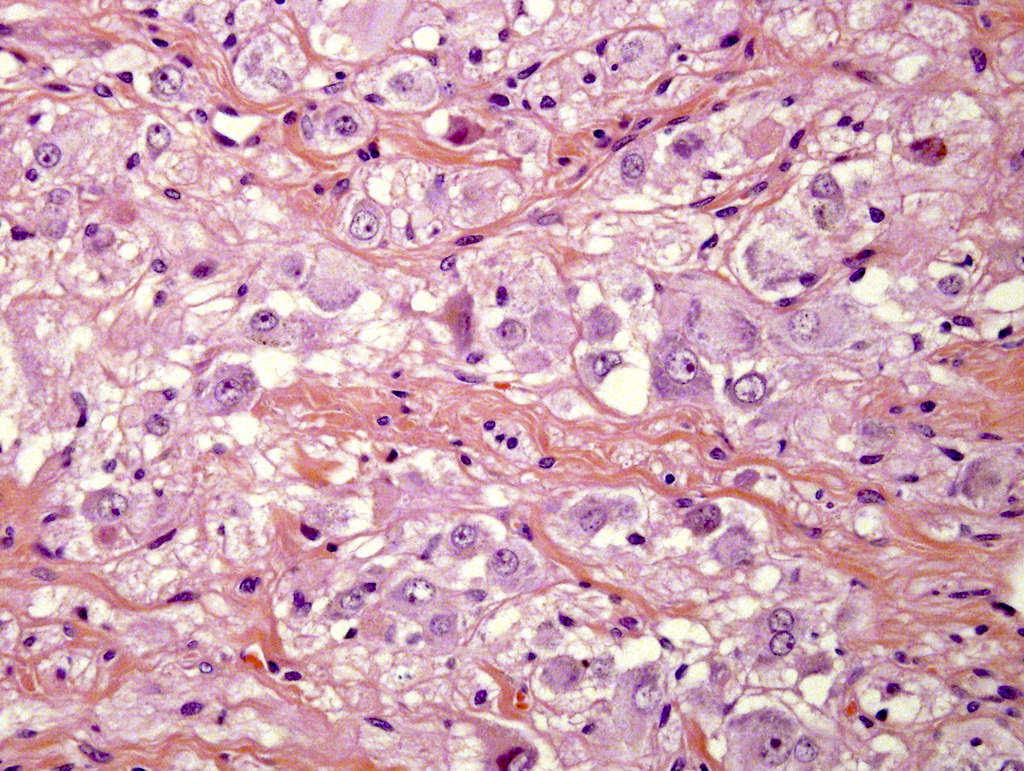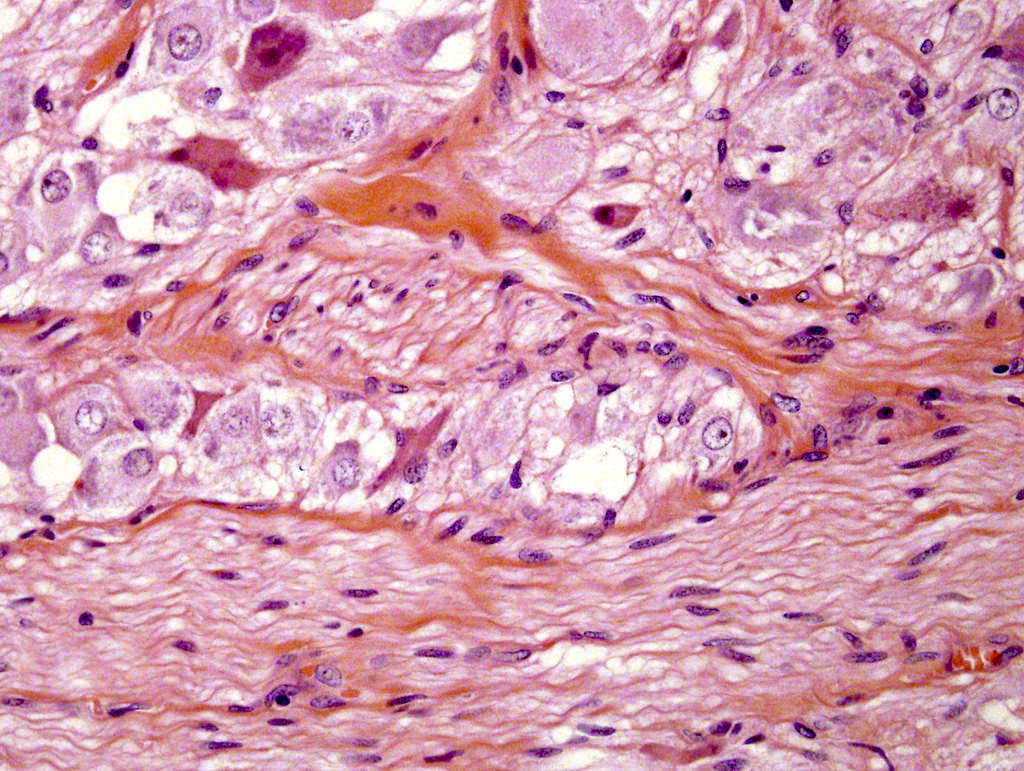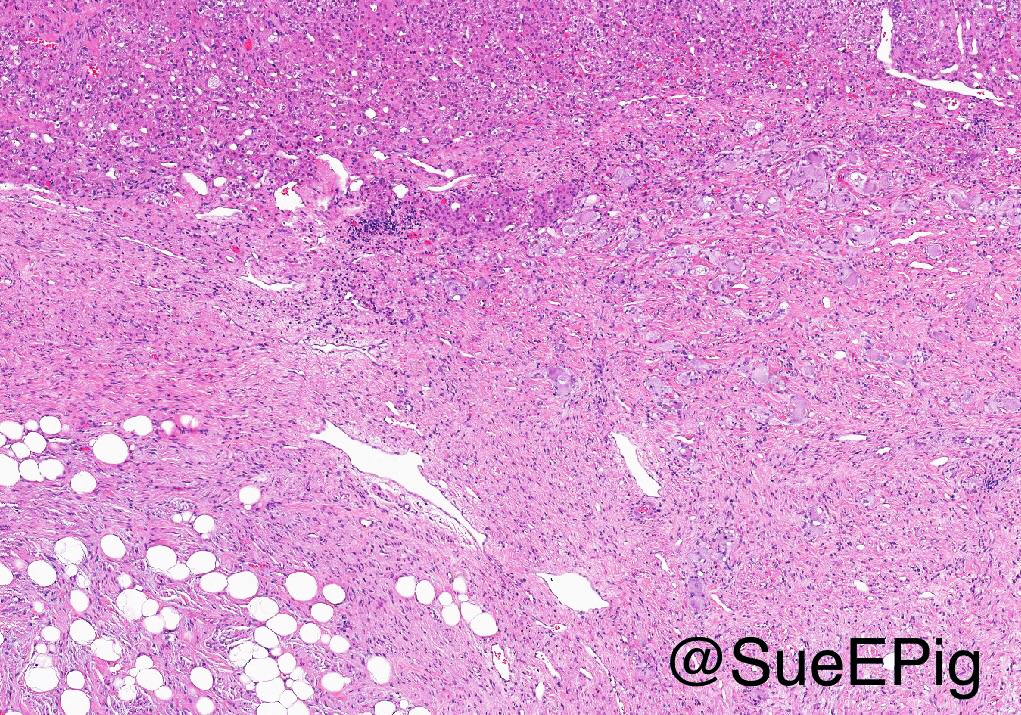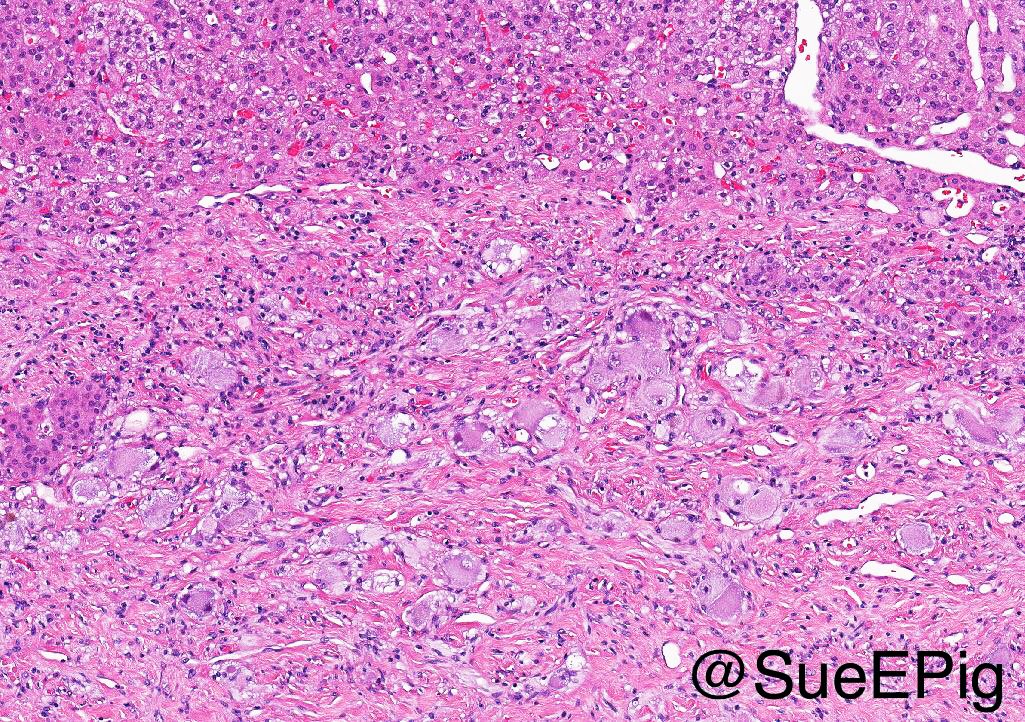Table of Contents
Definition / general | Epidemiology | Sites | Etiology | Clinical features | Diagnosis | Laboratory | Radiology description | Radiology images | Prognostic factors | Case reports | Treatment | Gross description | Gross images | Microscopic (histologic) description | Microscopic (histologic) images | Virtual slides | Cytology description | Cytology images | Positive stains | Negative stains | Electron microscopy description | Molecular / cytogenetics description | Differential diagnosisCite this page: Perrino C, Zynger DL. Ganglioneuroma. PathologyOutlines.com website. https://www.pathologyoutlines.com/topic/adrenalganglioneuroma.html. Accessed May 12th, 2024.
Definition / general
- Mature, benign neoplasm that originates from neural crest cells of sympathetic ganglia or adrenal medulla
- On a spectrum, from least → most differentiated: neuroblastoma → ganglioneuroblastoma → ganglioneuroma
Epidemiology
- At all sites, usually age ≥ 7 years old
- Patients with adrenal ganglioneuroma usually 4th to 5th decade (BMC Res Notes 2014;7:791)
- Patients with ganglioneuroma of retroperitoneum or posterior mediastinum usually children (BMC Res Notes 2014;7:791)
- M=F
- Familial disposition and associated with Turner syndrome, multiple endocrine neoplasia type 2 (MEN2) (BMC Res Notes 2014;7:791)
Sites
- Located along distribution of sympathetic nervous system
- Most commonly in posterior mediastinum, followed by retroperitoneum (especially presacral space)
- May occur in many locations, including adrenal gland (~20-30% of cases), cervical and parapharyngeal area, urinary bladder, prostate, bone, pancreas, skin, orbit, paratesticular area, appendix, gastrointestinal tract (Lack: Tumors of the Adrenal Glands and Extraadrenal Paraganglia, Vol.8, 2007)
Etiology
- Clonal proliferation of cells of neural crest origin
Clinical features
- Usually asymptomatic
- May have non-specific signs/symptoms such as abdominal pain, palpable abdominal mass
- Rarely, catecholamine synthesis may cause hypertension
Diagnosis
- Tumor comprised of admixture of ganglion cells and Schwannian stroma/cells
Laboratory
- Usually non-functional
- Occasionally increased vanilmandelic acid and homovanillic acid in urine
Radiology description
- Ultrasound: well-defined, homogeneous, hypoechogenic mass (BMC Res Notes 2014;7:791)
- Computed tomography (CT): circumscribed and well-defined, hypodense, homogeneous or slightly heterogeneous lesion, surrounds peripheral blood vessels without compression or occlusion, may have fine/punctate calcifications (~40-60%), poorly enhanced by contrast medium (<40 Hounsfield units) (BMC Res Notes 2014;7:791)
- Magnetic resonance imaging (MRI): (BMC Res Notes 2014;7:791)
- T1: homogeneous, signal intensity lower than liver
- T2: heterogeneous, signal intensity greater than liver; no absolute change in signal intensity on chemical shift imaging
- Gadolinium administration: delayed and progressive, non-intense enhancement
Prognostic factors
- Benign tumor, good prognosis following adrenalectomy, long term follow-up is recommended (J Med Case Rep 2014;8:131)
- Rarely malignant transformation of Schwannian stroma to malignant peripheral nerve sheath tumor (MPNST), may occur de novo or following abdominal radiation (Clin Endocrinol (Oxf) 2014;80:342)
Case reports
- 13 year old girl with ganglioneuroma and hereditary spherocytosis (Turk J Pediatr 2012;54:187)
- 15 year old girl with incidental adrenal mass (World J Surg Oncol 2012;10:64)
- 18 year old man with ganglioneuroma presenting as an adrenal incidentaloma (J Med Case Rep 2014;8:131)
- 21 year old woman with clinical acute pyelonephritis (Arq Bras Endocrinol Metabol 2012;56:270)
- 28 year old man with adrenal ganglioneuroma (BMC Res Notes 2014;7:791)
- 33 year old woman with laparoscopic extirpation of giant adrenal ganglioneuroma (J Minim Access Surg 2014;10:45)
- 37 year old woman with composite pheochromocytoma-ganglioneuroma of the adrenal gland (Urol Ann 2013;5:115)
- 41 year old man with large adrenal ganglioneuroma (Intern Med 2012;51:2365)
- 62 year old man with ganglioneuroma of the adrenal gland (Case Rep Oncol 2012;5:487)
- 69 year old woman with coexistence of renal cell carcinoma of clear cell type with sarcomatoid cell type component and adrenal mature ganglioneuroma with myelolipoma (Rom J Morphol Embryol 2014;55:425)
Treatment
- Adrenalectomy (J Med Case Rep 2014;8:131)
Gross description
- Well circumscribed
- May have true capsule or fibrous capsule
- Size varies, 8 cm to > 15 cm
- Firm, resilient texture
- Gray-white to tan-yellow
- May have trabecular or whorled appearance
Gross images
Microscopic (histologic) description
- Admixture of ganglion cells and Schwann cells
- Ganglion cells
- Mature to mildly dysmorphic
- Mature: compact, eosinophilic cytoplasm with distinct cell borders, single eccentric nucleus, prominent nucleolus
- Dysmorphic: single or multiple pyknotic nuclei
- Vary in distribution and number, may be quite sparse
- May contain finely granular, gold to brown pigment (lipofuscin or neuromelanin)
- Mature to mildly dysmorphic
- Schwann cells
- May ensheath neuritic processes
- May be arranged in small intersecting fascicles which are separated by loose myxoid stroma
- Two histologic subtypes:
- Mature = every ganglion cell is mature
- Maturing = minor component of scattered collections of differentiating neuroblasts or maturing ganglion cells
- Unlike intermixed subtype of ganglioneuroblastoma, these immature foci do not form distinct microscopic nests
- Background may include lobules of mature adipose tissue (especially at periphery of lesion), mast cells, chronic inflammation, dense collagenized stroma
- Mild variation in cellularity is permitted
- No significant atypia, mitoses, or necrosis should be present
- Masculinizing ganglioneuroma: admixture of ganglioneuroma and Leydig cells with crystalloids of Reinke or strands/clusters of cells resembling adrenal cortical cells
- Composite tumor: rare; usually ganglioneuroma and pheochromocytoma (ìcomposite pheochromocytomaî)
Microscopic (histologic) images
Virtual slides
Cytology description
- Biphasic with large, polyhedral ganglion cells and fibrillary stroma with spindle-shaped cells with cigar-shaped nuclei (J Cytol 2014;31:57)
Cytology images
Positive stains
- Schwann cells/stroma: S100, synaptophysin, neurofilament (NF) protein (Dabbs: Diagnostic Immunohistochemistry, 3rd Edition, 2010, J Med Case Rep 2014;8:131, Am J Pathol 1990;136:375)
- Ganglion cells: S100, synaptophysin, chromogranin A, NF protein, glial fibrillary acidic protein (GFAP), PGP 9.5, type IV collagen, vasoactive intestinal peptide (VIP) (Dabbs: Diagnostic Immunohistochemistry, 3rd Edition, 2010, Endocr Relat Cancer 2003;10:99, Am J Pathol 1990;136:375)
Negative stains
- EMA, cytokeratin, HMB45, WT1, CD99, CD45, desmin, myogenic markers (myogenin, MyoD1) (Dabbs: Diagnostic Immunohistochemistry, 3rd Edition, 2010)
Electron microscopy description
- Mixture of neural bundles and normal appearing ganglion cells with eccentric nuclei and large numbers of cytoplasmic organelles
Molecular / cytogenetics description
- Ganglioneuromas are not usually associated with genetic abnormalities (Clin Endocrinol (Oxf) 2014;80:342)
- RET mutational analysis negative in 4 cases (1 ganglioneuroma, 3 composite ganglioneuroma and pheochromocytomas) (J Clin Endocrinol Metab 2010;95:3118)
- Some still believe that there may be a causative role for an activating RET protooncogene mutation in the pathogenesis of adrenal ganglioneuromas (Clin Endocrinol (Oxf) 2014;80:342)
- RET protooncogene expressed at low levels in 1 of 3 ganglioneuromas (J Mol Med (Berl) 1996;74:617)
- 2 pediatric patients (one with MEN2A, one with MEN2B) with ganglioneuromas and no evidence of pheochromocytoma (J Clin Endocrinol Metab 2005;90:4383)
- MEN2A and MEN2B have rarely been associated with composite adrenal ganglioneuroma and pheochromocytoma (Clin Endocrinol (Oxf) 2014;80:342)
- Loss of heterozygosity (LOH) studies showed that chromosome 1 (1p34-36) and p53 (17p13.1), prognostic markers for neuroblastoma, were not detected in ganglioneuroblastoma (Endocr Relat Cancer 2003;10:99)
Differential diagnosis
- Adrenal cortical adenoma
- Carcinoma
- Composite pheochromocytoma
- Ganglioneuroblastoma
- Neuroblastoma
- Neurofibroma: especially if ganglion cells are sparse





